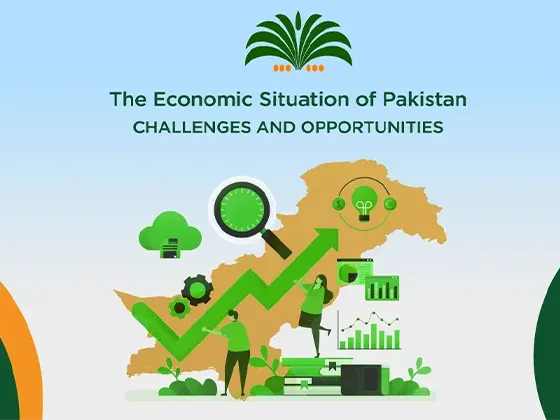Pakistan is a developing country in South Asia with a population of over 220 million people. The country has faced numerous economic challenges throughout its history, including high levels of poverty, low levels of foreign investment, and a struggling industrial sector. Despite these challenges, Pakistan has made significant progress in recent years, with a growing middle class, a thriving tech industry, and increased foreign investment. This article will examine the current economic situation in Pakistan, including its challenges and opportunities.
The Current Economic Situation
Pakistan’s economy is heavily reliant on agriculture, which accounts for approximately 24% of the country’s GDP and employs over 40% of its workforce. The industrial sector accounts for around 20% of GDP, while the services sector makes up the remaining 56%. The country has a large population of young people, with more than 60% of the population under the age of 30.
With a GDP growth rate of 3.9% in 2020, Pakistan’s economy has been growing steadily in recent years. This is lower than the 5.8% growth rate in 2018 but still represents a significant improvement over previous years. The country’s economic Growth is expected to continue in the coming years, with the International Monetary Fund (IMF) projecting a GDP growth rate of 4% in 2021.
One of the major challenges facing Pakistan’s economy is its current account deficit, which was estimated at $2.1 billion in March 2021. The deficit is primarily driven by a high import bill, particularly for oil and gas, which are critical to Pakistan’s energy needs. The country has been working to address this issue by increasing exports, particularly in the textile industry, which is Pakistan’s largest export industry.
Pakistan has also been working to increase its foreign investment, particularly in the energy and infrastructure sectors. The country has attracted significant investment from China through the China-Pakistan Economic Corridor (CPEC), a $62 billion project that includes the construction of power plants, roads, and ports. However, there are concerns that the project may result in a high debt burden for Pakistan, as well as environmental and social issues.
Inflation is another major challenge facing Pakistan’s economy, with the inflation rate reaching a 9-year high of 9.1% in May 2021. The rise in inflation is primarily driven by higher food prices, particularly for wheat, sugar, and edible oil. The government has taken several measures to address the issue, including increasing interest rates and importing essential commodities. However, these measures have had limited success so far.
Opportunities for Growth
Despite the challenges facing Pakistan’s economy, there are also several opportunities for Growth. One of the key opportunities is the country’s growing middle class, which is estimated to be around 40 million people. This represents a significant market for consumer goods and services, particularly in sectors such as retail, healthcare, and education.
Pakistan’s tech industry is also experiencing rapid Growth, with a number of successful startups emerging in recent years. The country has a large pool of young, tech-savvy workers, as well as a growing number of tech incubators and accelerators. The government has also launched several initiatives to support the Growth of the tech industry, including the establishment of a National Incubation Center and a National IT Board.
Pakistan’s strategic location is also an opportunity for economic growth, particularly in the context of the Belt and Road Initiative. The country is a key player in China’s plan to create a network of trade routes connecting China to Europe and beyond. This presents opportunities for Pakistan to develop its infrastructure and increase its connectivity to other countries in the region.
Finally, Pakistan’s agricultural sector has the potential for significant growth, particularly in the areas of high-value crops such as fruits, vegetables, and livestock. The country has favorable climatic conditions for agriculture and a large workforce in rural areas. The government has launched several initiatives to modernize the agricultural sector, including the establishment of special economic zones for agriculture, the provision of agricultural credit, and the introduction of new technologies for farming.
Challenges Ahead
While there are opportunities for Growth in Pakistan’s economy, there are also several challenges that must be addressed in order to realize its potential. One of the key challenges is the country’s energy crisis, which has resulted in frequent power outages and a high cost of electricity. The government has taken steps to address the issue, including the construction of new power plants and the promotion of
renewable energy. However, progress has been slow, and the energy crisis remains a major barrier to economic Growth.
Another challenge facing Pakistan is its low levels of human capital. The country has a relatively low literacy rate, with only around 60% of the population able to read and write. This limits the country’s ability to attract high-skill jobs and foreign investment in sectors such as technology and finance. The government has launched several initiatives to improve education, including the provision of free primary education and the establishment of new universities. However, progress has been slow, and the country continues to lag behind its peers in terms of human development.
Finally, Pakistan’s security situation remains a major concern for investors and businesses. The country has faced a long-standing insurgency in its western province of Balochistan, as well as terrorist attacks in major cities such as Karachi and Lahore. While the government has made progress in improving security in recent years, the situation remains volatile, and there are concerns that it could deter foreign investment and tourism.
The Role of the China-Pakistan Economic Corridor (CPEC)
One unique aspect of Pakistan’s economic situation is the China-Pakistan Economic Corridor (CPEC), a major infrastructure and development project that aims to connect China’s western region of Xinjiang with Pakistan’s Gwadar port on the Arabian Sea. The project includes the construction of highways, railways, pipelines, and other infrastructure projects, as well as the establishment of special economic zones and the development of renewable energy projects.
CPEC has the potential to transform Pakistan’s economy by improving connectivity and infrastructure, creating new jobs, and attracting foreign investment. The project is expected to create over 700,000 jobs and add 2-2.5% to Pakistan’s GDP by 2025. It is also expected to improve the country’s energy security by increasing the supply of electricity from China.
However, CPEC also presents some challenges for Pakistan. Critics have raised concerns over the project’s environmental impact, its impact on local communities, and the country’s ability to repay the debt incurred by the project. There are also concerns over the project’s potential to increase China’s influence in the region and its implications for regional stability.
The Pakistani government has taken steps to address these concerns, including the establishment of a CPEC Authority to oversee the project and ensure transparency and the inclusion of environmental and social safeguards in project planning and implementation. The government has also sought to diversify its sources of investment and trade, including by strengthening ties with other countries such as Turkey and Russia.
Overall, the success of CPEC will depend on the effective implementation of the project, as well as the ability of the Pakistani government to address the challenges it presents. If successful, CPEC has the potential to be a game-changer for Pakistan’s economy, improving connectivity and infrastructure, creating new jobs, and increasing foreign investment.
Conclusion
Pakistan’s economy has made significant progress in recent years, but there are still significant challenges that must be addressed in order to realize its potential. The country’s growing middle class, the tech industry, and strategic location present opportunities for Growth, but these must be balanced against challenges such as the energy crisis, low levels of human capital, and security concerns. The government must continue to prioritize economic reform and address these challenges in order to create a stable and prosperous future for Pakistan.

